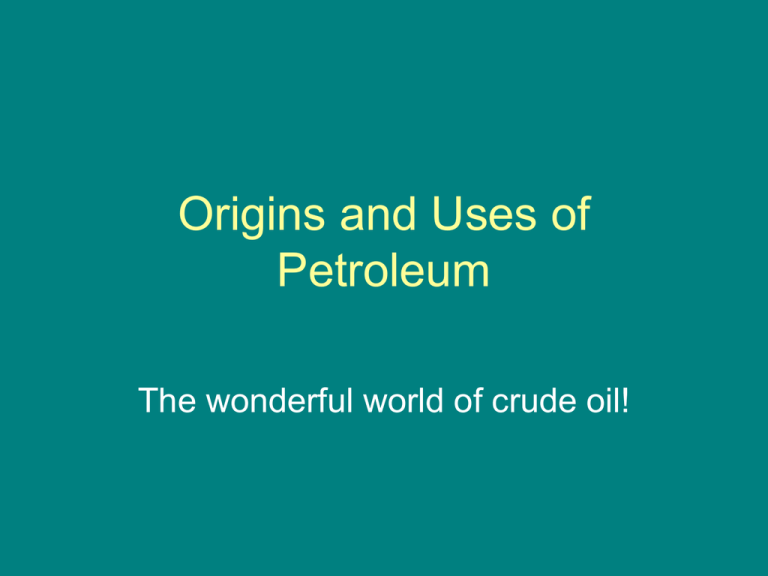Hydrocarbons for fuel and fun
advertisement

Origins and Uses of Petroleum The wonderful world of crude oil! What is a hydrocarbon? • The simplest type of organic substance • Made only of hydrogen and carbon. • Examples of hydrocarbons: gasoline, kerosene, natural gas, benzene, wax, and plastics such as polyethylene www.chemistryland.com What is Petroleum? • Some of the common fuels we use are derived from petroleum. • The word petroleum means “rock oil.” • Petroleum is a mixture of hydrocarbons. • www.soton.ac.uk Petroleum forms from plankton… These are diatoms, a type of phytoplankton These are examples of zooplankton http://en.wikipedia.org/wiki/Image:Tomopteriskils.jpg http://en.wikipedia.org/wiki/Image:Diatoms_through_the_microscope.jpg http://en.wikipedia.org/wiki/Image:Diatoms_through_the_mi croscope.jpg From Plankton to Petroleum … • The bodies of tiny plankton organisms are made up of primarily three types of atoms: carbon, hydrogen, and oxygen • Petroleum forms when partially decayed plankton gets “cooked” and “smushed” under layers of mud, sand, and rock. • The high temperatures and pressures causes the chemical rearrangement of the atoms and oxygen is released – forming the hydrocarbon mixture of petroleum! Here’s the way petroleum forms… http://www.earthguide.ucsd.edu/fuels/oil.html www.globalization101.org Crude oil from different places is not exactly the same Petroleum as it is collected from the ground is called crude oil. Crude oil can vary in … – Viscosity – how resistant it is to flowing – Color – can be yellow, red, green, brown, black – Other elements it contains (besides carbon, hydrogen, and sulfur) But crude oil typically has this composition (in percentages): metals, <1 salts,<1 oxygen, <1 nitrogen, <1 sulfur, 1-2 car bon hydrogen, 14 hydr ogen sul f ur met al s sal t s oxygen ni t r ogen carbon, 84 Ancient uses of petroleum • • • • To coat mummies To pave streets To waterproof reed boats For heating and medicine! http://www.plu.edu/~ryandp/RAX.html http://en.wikipedia.org/wiki/Mummies Magic cures! • Snake oil was a19thcentury American product • It was a type of cure-all or elixir often sold in traveling medicine shows. • Snake oil salesmen would falsely claim that the potions would cure any ailments. • But of course, it didn’t taste very good! http://en.wikipedia.org/wiki/Image:Snake-oil.png An early method to refine petroleum – the “tea kettle” still This is similar to the type of set-up used in tea kettle refining. The only product produced by tea kettle refining that was actually used was kerosene. http://www.dangerouslaboratories.org/moon1.html (But we know what Uncle Jesse was really making!) Uses of kerosene Kerosene was used to light lanterns. It replaced whale oil as the primary lantern oil. It was the first modern use of petroleum. Facts about “tea kettle: refining • By 1860 there were 15 refineries in operation. Known as "tea kettle" stills • They consisted of a large iron drum and a long tube which acted as a condenser. • Capacity of these stills ranged from 1 to 100 barrels a day. A coal fire heated the drum, and three fractions were obtained during the distillation process. • The first component to boil off was the highly volatile naphtha. (There was not a use for naphtha so it was not collected.) Next came the kerosene, or "lamp oil", and lastly came the heavy oils and tar which were simply left in the bottom of the drum. • These early refineries produced about 75% kerosene, which could be sold for high profits. http://www.pafko.com/history/h_petro.html Petroleum Saves the Whales! Whaling experienced a sharp decline after kerosene was used to light lanterns. This helped most whale populations to recover. http://www.atourhands.com/whaling.html A harvested whale Modern Uses of Petroleum… • • • • • • Gasoline Motor Oil Waxes Dyes Plastics Synthetic Fibers – for example, polyester •http://www.incpen.org/pages/data//Plastics.gif Petroleum Use Today • Approximately 90% of the crude oil recovered today is converted to a fuel! • 5% is used to produce plastics. • The remaining 5 % is used to make dyes, inks, household detergents, and medicines. A Fossil Fuel? Remember… Petroleum is called a fossil fuel because it formed from the remains of… Previously living critters! How is petroleum recovered from underground? 1. A well is drilled on land or under the ocean to reach an oil deposit 2. If the oil deposit has sufficient pressure, it will flow to the surface without having to pump it out of the ground 3. If the oil is not under high pressure, it must be pumped to the surface Sufficient pressure! http://www.inkart.com/pages/industry/Oil_Well.htm An offshore oil rig www.offshore-technology.com spot.colorado.edu http://www.oil-rig-jobs.com/ www.offshore-technology.com http://www.eia.doe.gov/kids/energy_fungames/energyant_trips/trip_offshore.html Large scale marine or offshore drilling involves lots of equipment (and uses lots of energy!) www.richard-seaman.com Two examples of oil derricks Derricks are structures that hold pumps (or drills) used to harvest oil and gas from beneath the ground. http://www.freepower.co.uk/site-3.htm Modern oil refining is done in many steps. • In the process of fractional distillation, crude oil is “taken apart” and separated into its main components or fractions. • Each fraction is a complex mixture of chemical compounds that have a similar boiling point. • Fractional distillation is carried out in large towers where crude oil is heated to 350 degrees C (or 662 degrees F) • Oil refineries are large, industrial complexes – as seen in the next slide. The Shell oil refinery at Martinez, California. The tapering vertical elements are smokestacks to create draft for heating units. Most of the complex vertical units are fractionating towers. Others are flares. http://en.wikipedia.org/wiki/Image:ShellMartinez-refi.jpg Fractional distillation – Inside a Fractioning Tower … • • • • • http://en.wikipedia.org/wiki/Image:Crude_Oil_Distillation.png Crude oil is separated into fractions by fractional distillation. Vapors from the hot crude oil rise up the tower, cool, and are removed as they condense back to liquids. The liquid fractions with the highest boiling points are removed from the lower sections of the tower. Fractions with the lowest boiling points are removed from the upper part of the tower. All of the fractions are routed to other refining units for further processing. The Complete Refining Process … • The complete refining process uses heat, pressure, chemicals, and catalysts to rearrange the structures of different hydrocarbons. • Additional gasoline is produced by catalytic cracking to break hydrocarbons into smaller molecules. Schematic flow diagram of a typical oil refinery http://en.wikipedia.org/wiki/Oil_refinery Lighter Hydrocarbons (The Gases) – are collected from the top of the tower Methane Butane Propane The green spheres represent carbon atoms and the silver one represent hydrogen atoms. The “sticks” between them are really chemical bonds formed by electrons moving back and forth between the atoms. http://www.nyu.edu/pages/mathmol/library/hydrocarbons/ Liquid Hydrocarbons… are collected from the middle of the tower. Gasoline molecules have from seven to 11 carbons in each chain. Octane, shown here, is one type of gasoline molecule. Other types are heptane (7 carbons), nonane (9 carbons), and decane (10 carbons) per chain Solid Hydrocarbons • Contain 20 carbons • Used as asphalt, tar, and plastics. How much energy is in a gallon of gasoline? • When you burn gasoline under ideal conditions, with plenty of oxygen, you get carbon dioxide (from the carbon atoms in gasoline), water (from the hydrogen atoms) and lots of heat. • If you took a 1,500-watt space heater and left it on full blast for a full 24-hour day, that's about how much heat is in a gallon of gas. • If it were possible for human beings to digest gasoline, a gallon would contain about 31,000 food calories -- the energy in a gallon of gasoline is equivalent to the energy in about 110 McDonalds hamburgers! (A gallon of 1% milk contains about 1760 calories!) • Above information from Howstuffworks.com The energy in 1 gallon of gasoline is equivalent to … 110 McDonalds hamburgers! Our current major sources of energy Natural Gas, 22% Petroleum, 38% Coal, 26% The remainder of our energy is supplied by nuclear power, hydroelectricity, and alternative sources such as wind, geothermal, hydrogen, and solar. Should the USA drill in ANWR? www.ens- newswire.com • This is the Alaska National Wildlife Refuge. • The debate of whether to drill for petroleum in ANWR is ongoing. • http://www.anwr.org/ Link to video clip “Gallon of Gas” • http://channel.nationalgeographic.com/seri es/man-made/3621/Overview#tabOverview




